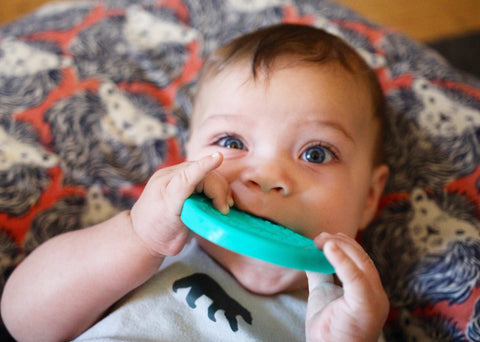Silicone + People & Planet

Silicone versus plastic?
When it comes to offering a highly durable and reusable food container that doesn’t leak and doesn’t contain the estrogen-mimicking chemicals commonly found in plastics, we believe that silicone is currently the best answer.
So why do we think silicone is a healthier choice than plastic when it comes to the environment and human health? Learn more about the differences between these two materials which can sometimes seem similar but are actually quite different.
- Non-toxic for people and planet + oceans
- One piece of silicone can be used for much longer than a similar piece of plastic
- How to choose food-safe silicone?
When it comes to the environment, silicone is highly durable and more ocean friendly than plastic.
In terms of toxicity, silicone is indisputably safer for human health than plastic, which is a petroleum-based material commonly containing estrogen-mimicking chemicals like bisphenol-A (BPA). Doctors, scientists and regulators point to a wide array of health problems stemming from BPA and other environmental toxins that are endocrine disruptors.
Plastics manufacturers have come under fire from consumers, scientists and regulators concerned about the many toxins used in plastics. Increasingly, plastic products are labelled BPA-free and consumers sometimes think these plastics are safe.
Researchers have determined that plastics manufacturers have removed BPA in order to label their products BPA-free and added instead a new chemical called BPS (bisphenol substitute) that’s believed to be more toxic than BPA.
Regardless of whether the plastic containers BPA or not, the non-biodegradable material is a huge contributor to pollution from the depths of our seas to the tops of our mountains. Scientists have found accumulations of plastic debris both big and micro everywhere on our planet and inside our bodies, including breast milk and pregnant mothers' placentas.
Non-toxic for people and planet + oceans
When it comes to the environment, silicone is highly durable and more ocean friendly than plastic. But what is silicone made of? Silicone, which is made from silica found in sand, is much longer lasting than plastic in the environment as well as while being used in products. Silicone endures extreme fluctuations in temperatures - from very cold to oven hot - without melting, cracking or otherwise degrading. This extreme durability is positive for numerous reasons.

“I really speak for the ocean. If we continue business as usual, we’re in real trouble,” said world-renowned oceanographer Sylvia Earle who is the author of “The World is Blue: How our Fate and the Ocean’s Are One” and the impetus for a new Netflix documentary. “In the last 25 years, I haven’t been diving anywhere, even 2 miles under the sea, without seeing some form of our trash, a lot of it plastic.”
One piece of silicone can be used for much longer than a similar piece of plastic
Silicone resists oxidative deterioration (normal aging) for decades on end. In fact, studies have shown that silicones thrive on challenges, including exposure to extreme heat and cold, harsh chemicals, sterilization, rain, snow, salt spray, ultraviolet radiation, ozone and acid rain, just to name a few.
Consumer advocate Debra Lynn Dadd conducted her own research into silicone rubbers and says silicone “is not toxic to aquatic or soil organisms, it is not hazardous waste, and while it is not biodegradable, it can be recycled after a lifetime of use.”
Civic recycling services are expanding the range of materials they collect every year, but if you can’t find a local spot to recycle your silicone lid, then we’ll take it back and make sure it gets recycled on your behalf.
If disposed of at a landfill for incineration, the silicone (unlike plastic) is converted back into inorganic, harmless ingredients: amorphous silica, carbon dioxide, and water vapor.
 When plastic, an organic material made from petroleum, is lost in the environment, it breaks down into micro-fragments which contaminate our lands and oceans as well as the animals living there. The estrogen-mimicking chemicals are then spread throughout the ecosystems, including oceans and land masses. Additionally, because plastics are more prone to breaking down into little bits, wildlife often mistakes the bright colorful bits of plastic trash for food. The plastic “food” is poison and blocks their digestive systems, often resulting in death.
When plastic, an organic material made from petroleum, is lost in the environment, it breaks down into micro-fragments which contaminate our lands and oceans as well as the animals living there. The estrogen-mimicking chemicals are then spread throughout the ecosystems, including oceans and land masses. Additionally, because plastics are more prone to breaking down into little bits, wildlife often mistakes the bright colorful bits of plastic trash for food. The plastic “food” is poison and blocks their digestive systems, often resulting in death.
How to choose food-safe silicone?
Still curious about the benefits of silicone as compared to plastics? Silicone is also odor and stain resistant. It’s hygienic and hypoallergenic with no open pores to harbor bacteria making it great for food containers and lunchware. It does not fade or scratch.
The key to being a careful consumer is to only buy high-quality silicone that’s food safe. Not all silicone is created equal. To reduce costs, some manufacturers add fillers to the product. Luckily there is a simple way to tell: pinch and twist a flat surface on the item. If white shows through, the product contains filler. Pure silicone, like the lids used in our Blue Water Bento collection, does not change color when twisted.
Check out an educational chart we've developed called Silicone Vs. Plastic: Learn Why Silicone is Better for People & Planet.
